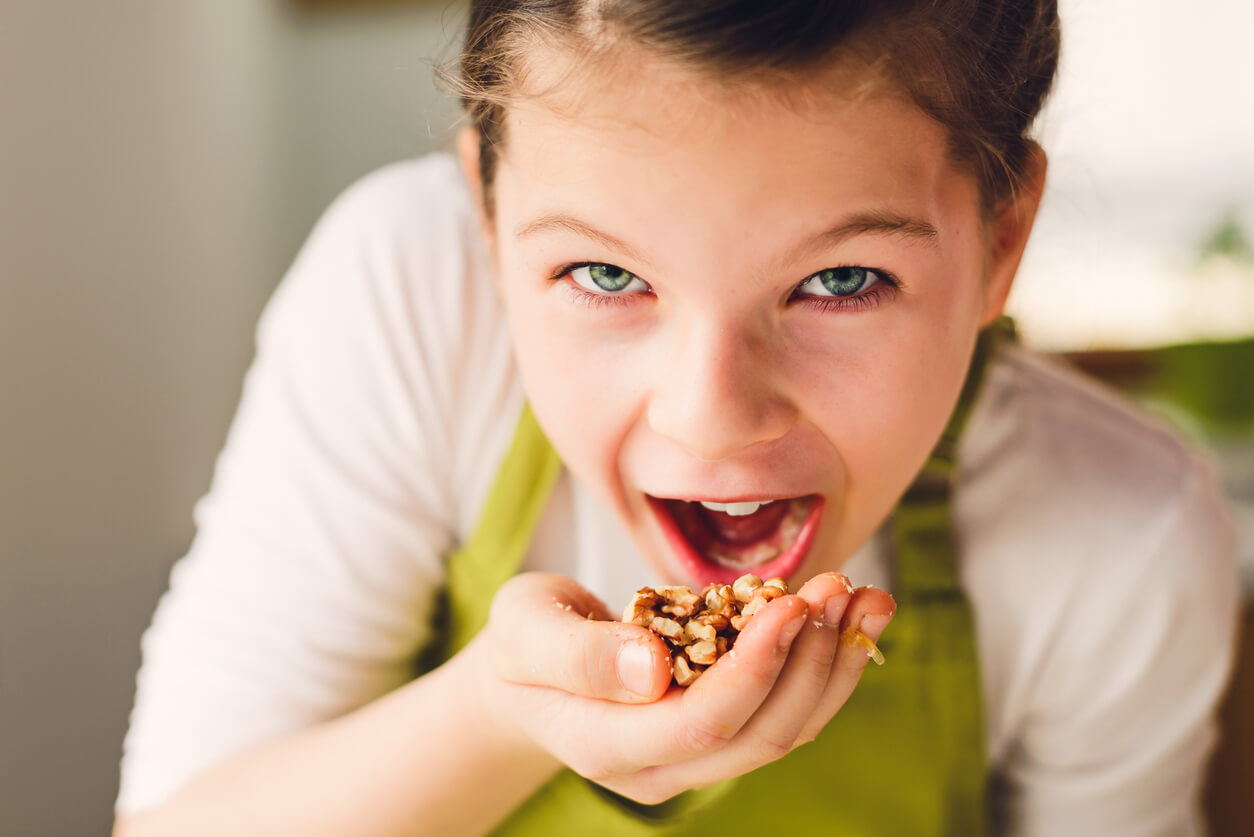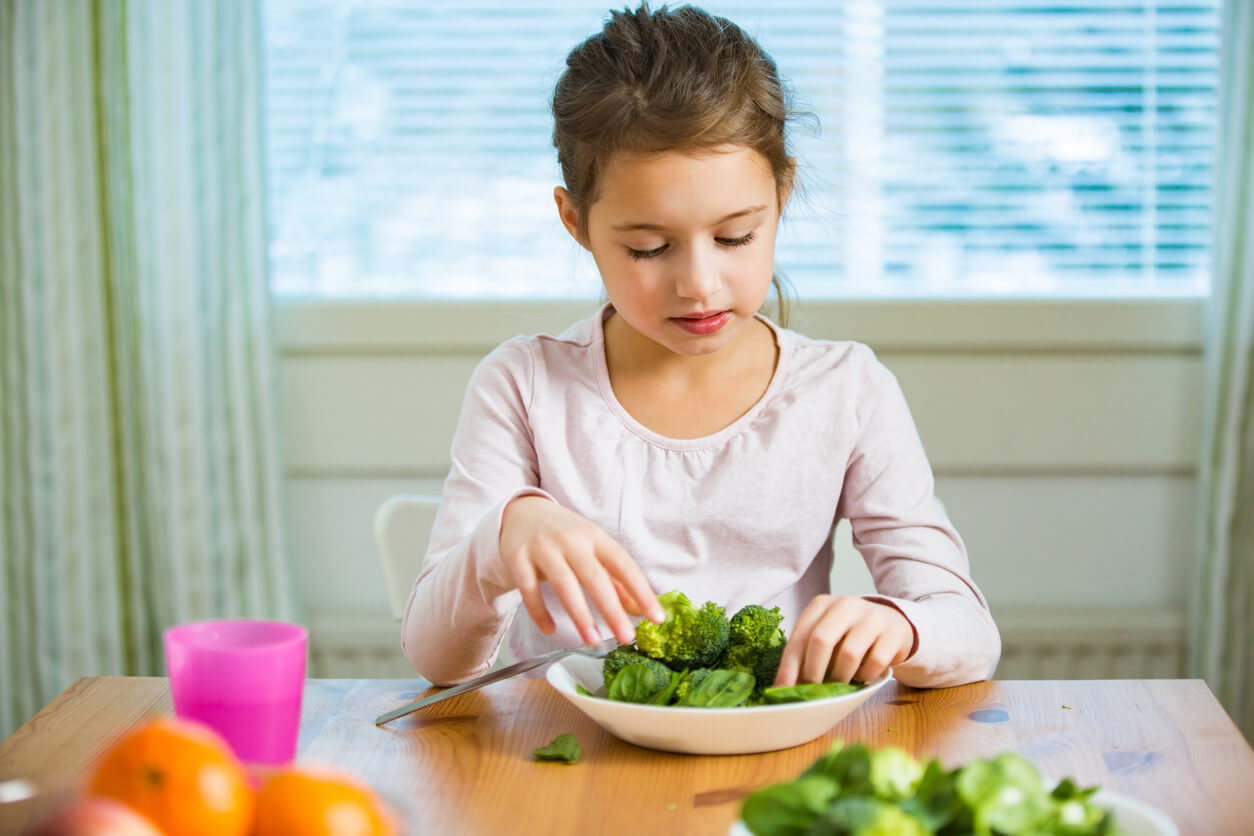Foods to Improve Concentration and Learning in Children

The brain is one of the most demanding and selective organs when it comes to nutrients. And the reason is that it’s always active, especially when it’s engaged in a learning process. In our children, good brain nutrition begins in the womb and should continue until after birth. So, foods to improve concentration and learning in children must be chosen carefully.
But what does science say about food, nutrients, and the learning process? Keep reading to learn more about this topic.
The importance of a good diet
All nutrients are necessary for the brain, but some in particular are closely related to cognition and learning. Better school performance comes from the brain’s ability to process, integrate, and memorize all of the knowledge acquired.
These nutrients are found in the different food groups that our children sometimes don’t consume. By knowing what they are, we’ll be able to highlight them in their diet. Therefore, let’s review below the best foods for good brain function in our children.
Foods to stimulate concentration and learning
The child’s diet to strengthen learning should be varied, balanced, and specific. Keep in mind that certain nutrients allow the good development of brain functions. Fruits, vegetables, whole grains, legumes, and some types of meat are the best vehicles for this.
1. Carbohydrates
The brain needs a continuous supply of energy to maintain cognitive capacity. This is achieved through glucose, a type of carbohydrate also known as the sugar in food. The area of the brain that’s key to learning and memory is sensitive to its absence. Therefore, we can’t omit it from the diet.
Glucose can be in foods in its natural form or as part of other carbohydrates, such as starch. But, when selecting them, we should include those that have a low glycemic index (GI). This is a numerical value that indicates how quickly or slowly a carbohydrate is absorbed during digestion. The Madrid Diabetes Society selects foods based on this index and classifies them as high, moderate, and low.
According to some experts, low-GI foods decrease insulin resistance. This can improve attention, memory, and comprehension when compared to high-GI foods.

Eat several times a day
Another tip is to distribute foods between 4 or 5 several meals throughout the day at regular times in order to keep blood sugar stable. Also, be careful at breakfast, which should be rich in carbohydrates.
As for dairy products, dairy ice creams and rice puddings should be excluded. With cereals, you need to be more careful, as there are few that have a low GI. These include whole grains, oatmeal, coconut and almond flours, and others.
2. Proteins
Proteins participate in the synthesis of neurotransmitters such as serotonin, dopamine, and adrenaline. Particularly, low levels of serotonin are associated with decreased learning, reasoning, and memory. Serotonin is also known as the “happiness hormone” and is formed from the essential amino acid tryptophan. A study showed that tryptophan supplementation improves attention, visual memory, and learning.
This amino acid is found in eggs, milk, fish, and meat. In addition, whole grains, nuts, legumes, bananas, pineapple, and avocado contain it in good proportion.
3. Healthy fats are foods to improve concentration and learning in children
If there’s an organ that needs good fats to function, it’s the brain. And it’s polyunsaturated fatty acids that lead the way, as saturated fat leads to cognitive impairment. In addition, DHA, an omega-3 fatty acid, is the main component of brain cell membranes and also produces neurotransmitters. A review showed that it’s key to cognitive development, learning ability, and memory.
Science has observed a significant improvement in children’s mental performance when supplemented with DHA. For their part, premature babies fed with formulas enriched with this fatty acid increased their intelligence quotient during adolescence. The sources of DHA are oily fish and nuts.
At the same time, omega-6 intake should also be satisfied. The journal Neuropsychology points out that consumption should be 5 parts omega-6 to 1 part omega-3. This ratio is associated with better memory and lower cognitive risk.

4. Trace elements and vitamins
Iron is a fundamental mineral in the myelination of neurons and in the production of neurotransmitters. A review concluded that iron deficiency anemia decreases concentration, performance, reasoning, and memory. Iodine, on the other hand, is also necessary for brain and mental development. Food sources of iron are meat, fish, poultry, offal, and legumes.
Green leafy vegetables, such as spinach, chard, or watercress, also provide iron. However, iron of vegetable origin should be consumed with fruits that provide vitamin C to improve its absorption. At the same time, B complex vitamins are essential for good brain function. B6 and B12 are used to produce neurotransmitters. A thiamine deficiency can lead to poor concentration and memory.
Other studies have found that vitamin D deficiency is associated with cognitive impairment. Choline is a precursor of acetylcholine, a neurotransmitter that has an effect on memory and learning. Grains, vegetables, seeds, and legumes contain B vitamins, while vitamin D is found in fortified milks, fatty fish, and organ meats.
Other important dietary components
Some natural antioxidants in foods can prevent damage from oxidative stress and, therefore, reduce cognitive decline. These include vitamin C, vitamin E, beta-carotene, zinc, and selenium. Carotenoids, such as lutein and zeaxanthin, help protect the brain from oxidative and inflammatory stress. In addition, it’s important to drink enough water to help cognitive performance.
We must educate children about foods to improve concentration and learning
To improve children’s concentration and learning, it’s best to educate them about healthy eating and nutrition, with the help of a dietitian nutritionist. When the diet is balanced, varied, and sufficient in quality and quantity, it guarantees all the nutrients and energy required for correct brain function in children.
But, if we want to improve cognitive processes, we must focus on selecting low-GI foods and polyunsaturated fats through fatty fish, nuts, and vegetable oils. Also, some animal proteins should be increased. In addition, remember that bananas, pineapple, and avocado are good sources of tryptophan, so in addition to improving your children’s learning, they’ll be happier.
The brain is one of the most demanding and selective organs when it comes to nutrients. And the reason is that it’s always active, especially when it’s engaged in a learning process. In our children, good brain nutrition begins in the womb and should continue until after birth. So, foods to improve concentration and learning in children must be chosen carefully.
But what does science say about food, nutrients, and the learning process? Keep reading to learn more about this topic.
The importance of a good diet
All nutrients are necessary for the brain, but some in particular are closely related to cognition and learning. Better school performance comes from the brain’s ability to process, integrate, and memorize all of the knowledge acquired.
These nutrients are found in the different food groups that our children sometimes don’t consume. By knowing what they are, we’ll be able to highlight them in their diet. Therefore, let’s review below the best foods for good brain function in our children.
Foods to stimulate concentration and learning
The child’s diet to strengthen learning should be varied, balanced, and specific. Keep in mind that certain nutrients allow the good development of brain functions. Fruits, vegetables, whole grains, legumes, and some types of meat are the best vehicles for this.
1. Carbohydrates
The brain needs a continuous supply of energy to maintain cognitive capacity. This is achieved through glucose, a type of carbohydrate also known as the sugar in food. The area of the brain that’s key to learning and memory is sensitive to its absence. Therefore, we can’t omit it from the diet.
Glucose can be in foods in its natural form or as part of other carbohydrates, such as starch. But, when selecting them, we should include those that have a low glycemic index (GI). This is a numerical value that indicates how quickly or slowly a carbohydrate is absorbed during digestion. The Madrid Diabetes Society selects foods based on this index and classifies them as high, moderate, and low.
According to some experts, low-GI foods decrease insulin resistance. This can improve attention, memory, and comprehension when compared to high-GI foods.

Eat several times a day
Another tip is to distribute foods between 4 or 5 several meals throughout the day at regular times in order to keep blood sugar stable. Also, be careful at breakfast, which should be rich in carbohydrates.
As for dairy products, dairy ice creams and rice puddings should be excluded. With cereals, you need to be more careful, as there are few that have a low GI. These include whole grains, oatmeal, coconut and almond flours, and others.
2. Proteins
Proteins participate in the synthesis of neurotransmitters such as serotonin, dopamine, and adrenaline. Particularly, low levels of serotonin are associated with decreased learning, reasoning, and memory. Serotonin is also known as the “happiness hormone” and is formed from the essential amino acid tryptophan. A study showed that tryptophan supplementation improves attention, visual memory, and learning.
This amino acid is found in eggs, milk, fish, and meat. In addition, whole grains, nuts, legumes, bananas, pineapple, and avocado contain it in good proportion.
3. Healthy fats are foods to improve concentration and learning in children
If there’s an organ that needs good fats to function, it’s the brain. And it’s polyunsaturated fatty acids that lead the way, as saturated fat leads to cognitive impairment. In addition, DHA, an omega-3 fatty acid, is the main component of brain cell membranes and also produces neurotransmitters. A review showed that it’s key to cognitive development, learning ability, and memory.
Science has observed a significant improvement in children’s mental performance when supplemented with DHA. For their part, premature babies fed with formulas enriched with this fatty acid increased their intelligence quotient during adolescence. The sources of DHA are oily fish and nuts.
At the same time, omega-6 intake should also be satisfied. The journal Neuropsychology points out that consumption should be 5 parts omega-6 to 1 part omega-3. This ratio is associated with better memory and lower cognitive risk.

4. Trace elements and vitamins
Iron is a fundamental mineral in the myelination of neurons and in the production of neurotransmitters. A review concluded that iron deficiency anemia decreases concentration, performance, reasoning, and memory. Iodine, on the other hand, is also necessary for brain and mental development. Food sources of iron are meat, fish, poultry, offal, and legumes.
Green leafy vegetables, such as spinach, chard, or watercress, also provide iron. However, iron of vegetable origin should be consumed with fruits that provide vitamin C to improve its absorption. At the same time, B complex vitamins are essential for good brain function. B6 and B12 are used to produce neurotransmitters. A thiamine deficiency can lead to poor concentration and memory.
Other studies have found that vitamin D deficiency is associated with cognitive impairment. Choline is a precursor of acetylcholine, a neurotransmitter that has an effect on memory and learning. Grains, vegetables, seeds, and legumes contain B vitamins, while vitamin D is found in fortified milks, fatty fish, and organ meats.
Other important dietary components
Some natural antioxidants in foods can prevent damage from oxidative stress and, therefore, reduce cognitive decline. These include vitamin C, vitamin E, beta-carotene, zinc, and selenium. Carotenoids, such as lutein and zeaxanthin, help protect the brain from oxidative and inflammatory stress. In addition, it’s important to drink enough water to help cognitive performance.
We must educate children about foods to improve concentration and learning
To improve children’s concentration and learning, it’s best to educate them about healthy eating and nutrition, with the help of a dietitian nutritionist. When the diet is balanced, varied, and sufficient in quality and quantity, it guarantees all the nutrients and energy required for correct brain function in children.
But, if we want to improve cognitive processes, we must focus on selecting low-GI foods and polyunsaturated fats through fatty fish, nuts, and vegetable oils. Also, some animal proteins should be increased. In addition, remember that bananas, pineapple, and avocado are good sources of tryptophan, so in addition to improving your children’s learning, they’ll be happier.
All cited sources were thoroughly reviewed by our team to ensure their quality, reliability, currency, and validity. The bibliography of this article was considered reliable and of academic or scientific accuracy.
- Andruchow, N. D., Konishi, K., Shatenstein, B., & Bohbot, V. D. (2017). A lower ratio of omega-6 to omega-3 fatty acids predicts better hippocampus-dependent spatial memory and cognitive status in older adults. Neuropsychology, 31(7), 724–734. https://doi.org/10.1037/neu0000373
- Bourre J. M. (2006). Effects of nutrients (in food) on the structure and function of the nervous system: update on dietary requirements for brain. Part 1: micronutrients. The journal of nutrition, health & aging, 10(5), 377–385.
- Hashimoto M.(2014) [Omega-3 fatty acids and cognition]. Nihon Rinsho;72(4):648-56. Japanese. PMID: 24796092.
- Hibbeln JR, Davis JM, Steer C, Emmett P, Rogers I, Williams C, et al. Consumption of maternal shellfish in pregnancy and neurodevelopmental outcomes in childhood (ALSPAC study): an observational cohort study. Lancet 2007;369:578-85
- Isaacs EB, Gadian DG, Sabatini S, Chong WK, Quinn BT, Fischl BR, et al. The effect of early human diet on caudate volumes and IQ. Pediatr Res 2008;63(3):308-14. Tambi
- Mohajeri MH, Wittwer J, Vargas K, Hogan E, Holmes A, Rogers PJ, Goralczyk R, Gibson EL. (2015). Chronic treatment with a tryptophan-rich protein hydrolysate improves emotional processing, mental energy levels and reaction time in middle-aged women. Br J Nutr. 28;113(2):350-65. doi: 10.1017/S0007114514003754. Epub 2015 Jan 9. PMID: 25572038.
- Montse Vilaplana i Batalla. (2016). Alimentación y neuronas. Farmacia Profesional. 30,6, 17-20.
- Seetharaman S, Andel R, McEvoy C, Dahl Aslan AK, Finkel D, Pedersen NL. Blood glucose, diet-based glycemic load and cognitive aging among dementia-free older adults. (2015). J Gerontol A Biol Sci Med Sci; 70(4):471-9. doi: 10.1093/gerona/glu135. Epub 2014 Aug 22. PMID: 25149688; PMCID: PMC4447796.
This text is provided for informational purposes only and does not replace consultation with a professional. If in doubt, consult your specialist.








